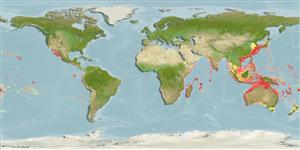Common names from other countries
Teleostei (teleosts) >
Tetraodontiformes (Puffers and filefishes) >
Tetraodontidae (Puffers) > Canthigasterinae
Etymology: Canthigaster: Greek, kanthos = the outer or inner corner of the eye, where the lids meet, 1646 + Greek, gaster = stomach (Ref. 45335).
More on authors: Temminck & Schlegel.
Environment: milieu / climate zone / depth range / distribution range
Ecology
Marine; reef-associated; depth range 0 - 350 m (Ref. 11441). Tropical
Indo-Pacific: East Africa south to Natal, South Africa (Ref. 4919) and east to Hawaii, north to southern Japan, south to northwestern Australia (Ref. 3132). Recorded in Kermadec Island.
Size / Weight / Age
Maturity: Lm ? range ? - ? cm
Max length : 18.0 cm TL male/unsexed; (Ref. 9710)
Dorsal spines (total): 0; Dorsal soft rays (total): 9 - 10; Anal spines: 0; Anal soft rays: 9 - 10. Body with 2 longitudinal dark bands that join in front of gill slit, lower band faint or absent; small dark spots ventrally; caudal fin with dark stripes; dark blotch at caudal base (Ref. 4919).
Inhabits rocky and coral reefs (Ref. 9710). Benthopelagic (Ref. 58302). A deep water species known from trawls, rarely seen by diving and occasionally visits deep sandy slopes where upwellings occur (Ref. 48637).
Life cycle and mating behavior
Maturities | Reproduction | Spawnings | Egg(s) | Fecundities | Larvae
Smith, M.M. and P.C. Heemstra, 1986. Tetraodontidae. p. 894-903. In M.M. Smith and P.C. Heemstra (eds.) Smiths' sea fishes. Springer-Verlag, Berlin. (Ref. 4919)
IUCN Red List Status (Ref. 130435)
CITES (Ref. 128078)
Not Evaluated
Threat to humans
Venomous
Human uses
Fisheries: of no interest; aquarium: commercial
Tools
Special reports
Download XML
Internet sources
Estimates based on models
Preferred temperature (Ref.
115969): 15.3 - 27.8, mean 23.7 (based on 784 cells).
Phylogenetic diversity index (Ref.
82804): PD
50 = 0.5000 [Uniqueness, from 0.5 = low to 2.0 = high].
Bayesian length-weight: a=0.03631 (0.01554 - 0.08482), b=2.88 (2.69 - 3.07), in cm Total Length, based on LWR estimates for this Genus-body shape (Ref.
93245).
Trophic level (Ref.
69278): 3.1 ±0.3 se; based on size and trophs of closest relatives
Resilience (Ref.
120179): High, minimum population doubling time less than 15 months (Preliminary K or Fecundity.).
Fishing Vulnerability (Ref.
59153): Low vulnerability (10 of 100).
